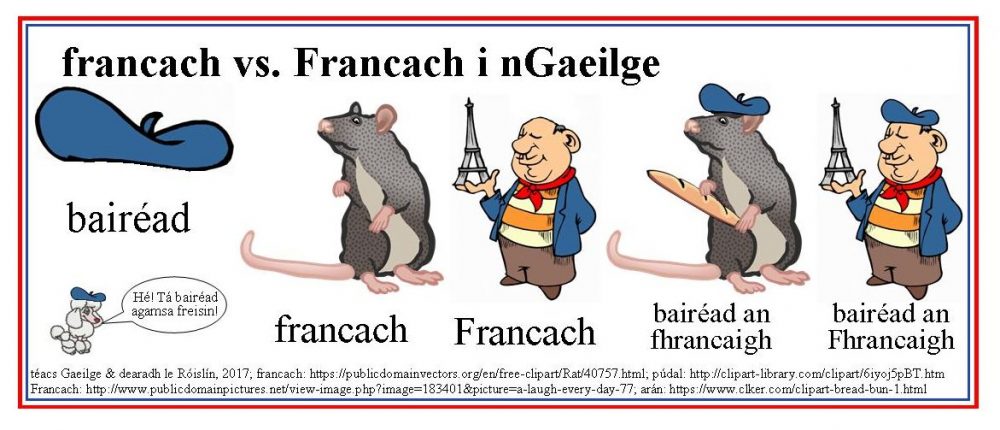Whose beret? Bairéad an fhrancaigh nó bairéad an Fhrancaigh? Nó bairéad an phúdail? (Showing possession in Irish) Posted by róislín on Sep 28, 2017 in Irish Language
(le Róislín)
Let’s take a short break from the actual vocabulary we’ve been working on for “An Píobaire Breac,” Seán Ó Dúrois’s translation of Robert Browning’s “The Pied Piper of Hamelin” (nasc agus eolas foilseacháin thíos).
With rats as the inspiration, as you can see in the graphic above, I thought it would be fun to work on the Irish way to show possession, using forms from “an tuiseal ginideach” (the Irish language term for “the genitive case”). The good news is we’ll just be looking at one category of noun, so there’s no real change in the pattern.
The graphic shows a beret (bairéad), a rat (francach), and a Frenchman (Francach), and both the francach and the Francach are wearing berets (now that involved a lot of graphics manipulation!). For good measure, I also threw in a púdal — if any dog should be wearing a beret, surely this is the pór (breed). Although, come to think of it, the “bulladóir Francach” would also be a good choice.
What happens to these words when we want to say “of the rat,” “of the Frenchman,” or “of the poodle”?
Two basic changes, one at the beginning of each word (called “lenition) and the other at the end, called “slenderization.”
If we start out with “an francach,” we’ll get “an fhrancaigh” for showing possession, The “fh-” is silent and the “gh” at the end is essentially silent and the “-ai-” is like “ee,” giving us a sound like “RAHN-kee.” Except in Cork or Kerry, where it might be “rahn-KIG,” with the “gh” pronounced like a hard “g” (as in “girl”). So, “the beret of the rat” (or “the rat’s beret”) is “bairéad an fhrancaigh.””
Capitalized or not, the pattern and pronunciation are the same, “bairéad an Fhrancaigh” (the beret of the Frenchman), which is pronounced the same as “the beret of the rat.”
Wanna try the plural? “Bairéad” becomes “bairéid” and “of the rats” becomes “na bhfrancach.” The “bhf” is pronounced like “v” and the final “ch” is like the German “Buch” or the Welsh “bach.” The phrases are “bairéid na bhfrancach” and “bairéid na bhFrancach.”
“Púdal” follows the same basic pattern. First, lenition, so the “p” changes to “ph,” pronounced “f.” And there is slenderization at the end, but without so drastic a pronunciation change as “-ach” becoming “-aigh.” The “-al” becomes “-ail,” with the letter “l” like the “l” in “lisp,” not like the “l” of “Louisville.” So we end up with “bairéad an phúdail” [… un FOO-dil]. And if we wanted to include the “bulladóir Francach,” we’d have to adjust the adjective “Francach” as well as “bulladóir” itself: bairéad an bhulladóra fhrancaigh.” Mh’anam! Tá an t-aguisín daoibhse, a Pepper, a Peaches, a Asia agus a Koji, a Gary, a Popeye, agus a Gypsy Rosa! Cé leo na bulladóirí francacha seo? In ord na n-ainmneacha: le Reese Witherspoon, le Hilary Duff, le Lady Gaga, le Carrie Fisher nach maireann (Cé atá ag tabhairt aire don mhaidrín anois, an bhfuil a fhios ag éinne?), le Eva Longoria, agus le Madonna. Is clúiteach na bulladóirí iad sin, agus a n-úinéirí freisin.
Plural, anyone? Bairéid na bpúdal and bairéid na mbulladóirí Francacha.
BTW, the one time I had a French exchange student in my Irish class, he just chuckled over the whole rat/Frenchman thing, so I hope everyone takes it in stride. The most plausible explanation I have heard for this linguistic interchange assumes that rats were unknown in ancient Ireland and that they came over in French ships, hence the “luch fhrancach” concept, mentioned in previous blogposts. I’ve also heard the same thing about coiníní (rabbits), the main difference being that we usually consider rabbits to be cute attractive animals, and take steps to attract and protect them. Rats, not surprisingly, are not generally looked upon in such a favorable light. Bhuel, sin é don bhlagmhír seo. SGF — Róislín
Nasc: How to say ‘rat’ in Irish and an additional glossary for reading ‘An Píobaire Breac’ (an t-aistriúchán le Seán Ó Dúrois) (Cuid 1 as 2)Posted by róislín on Sep 23, 2017 in Irish Language
Eolas foilseacháin: Ó Dúrois, Seán. An Píobaire Breac agus dánta eile do pháistí. Binn Éadair, Baile Átha Cliath, 2004. Gan ISBN sa chóip atá agamsa.

Build vocabulary, practice pronunciation, and more with Transparent Language Online. Available anytime, anywhere, on any device.





Leave a comment: